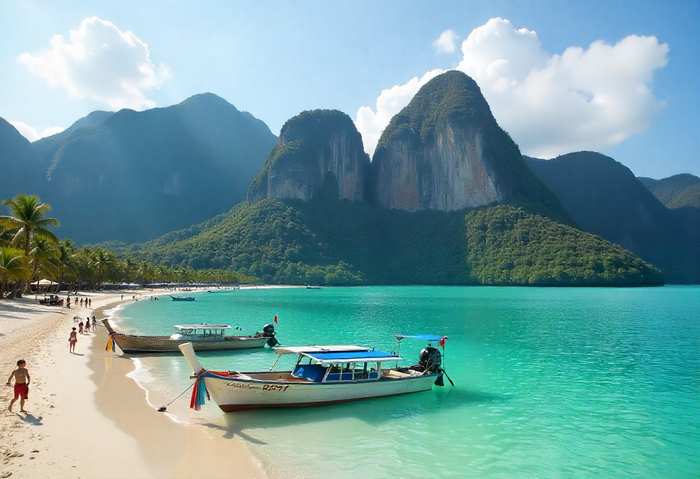Published on
November 16, 2025
Thailand joins Panama, Mexico, Iceland, Australia, Philippines, Spain, and Italy among the world’s most influential tourism destinations, propelled by a blend of genuine hospitality, cultural richness, and a surge in global travel demand. These countries captivate millions with their warm communities and immersive experiences, yet each is also grappling with the pressures of rapid tourism growth, from congested urban spaces to stretched local infrastructure. Their collective trajectory highlights a global turning point, where destinations must balance visitor appeal with sustainable planning to safeguard communities and environments. Together, they demonstrate the need for modern tourism leaders to evolve quickly, embracing strategies that protect long-term quality of life while preserving their welcoming spirit.
Stepping into a new country can define a traveler’s entire experience, shaped immediately by local warmth and first impressions. As worldwide tourism accelerates, recent insights from 2024 and 2025 reveal which nations continue to excel in hospitality—and which are beginning to feel the strain of ever-growing crowds.
Panama – A Genuine Welcome at Every Turn
Panama has emerged as one of the most welcoming nations for newcomers, thanks to its relaxed lifestyle, accessible visa options, and affordable living conditions. A large majority of expats reported that their income easily supports a comfortable lifestyle, while many praised how simple it is to form connections, integrate into local communities, and enjoy a balanced life.
The country’s blend of tropical scenery, easygoing culture, and sincere approach to hospitality has made it a top pick for retirees and remote workers seeking a sense of belonging.
Mexico – Warmth That Feels Like Home
Mexico continues to shine as one of the friendliest destinations for long-term stays and tourism alike. A significant share of expats describe the country as welcoming, citing its vibrant culture, affordability, and open-hearted residents. Tourism remains one of Mexico’s biggest strengths, attracting millions with its beaches, historic ruins, and dynamic cuisine.
Despite high visitor numbers, the spirit of friendliness has stayed strong, creating an environment where travelers feel both included and encouraged to explore beyond the usual hotspots.
Iceland – A Small Nation With a Big Heart
Iceland’s dramatic landscapes capture global attention, but its hospitality leaves an equally lasting impression. Even after years of rapid tourism growth, residents have preserved a culture of openness and helpfulness. Travelers often speak of the ease with which locals offer guidance, share stories, and make visitors feel like part of a tight-knit community.
Though tourism has skyrocketed, the island continues to uphold a reputation for sincerity and inclusivity.
Australia – Hospitality With a Laid-Back Spirit
Australia’s welcoming nature is deeply tied to its cultural values. Whether in remote red-desert towns or bustling coastal cities, visitors encounter an easygoing attitude grounded in openness and community spirit. The country’s diverse population and adventurous mindset help foster environments where travelers feel supported, understood, and encouraged to explore.
The Philippines – Heartfelt Hospitality Across Islands
Friendly interactions are one of the Philippines’ strongest tourism assets. Visitors often highlight how locals go out of their way to offer assistance, share cultural traditions, and create memorable encounters. With a high level of English proficiency, communication feels smooth and accessible, eliminating barriers that travelers commonly face in other destinations.
From bustling cities to remote island villages, a culture of warmth continues to define the Filipino travel experience.
Spain – Beloved, Busy, and Becoming Overwhelmed
Spain remains one of the world’s most visited countries, receiving tens of millions of travelers annually. While tourism provides substantial economic benefits, 2024 marked a shift in public sentiment as overtourism fears intensified. Several regions saw large-scale demonstrations calling for more sustainable visitor management, driven by concerns over housing pressure, crowding, and environmental impact.
These movements were not targeted at travelers themselves, but at policies that have allowed visitor numbers to rise faster than local infrastructure can manage.
Italy – Charm Meets Pressure From Overtourism
Italy’s beauty continues to attract surging visitor numbers, prompting many cities to introduce new crowd-control measures. Popular destinations like Venice and Florence have enacted limits on large tour groups, implemented congestion signals, and created regulations to preserve access to public spaces.
Venice’s introduction of a day-trip entry fee marked a global first, highlighting the growing urgency for more sustainable tourism models. While friendliness persists in everyday interactions, the country is increasingly focused on balancing tourism with quality of life for residents.
Thailand – Warm Hospitality Tempered by Language Challenges
Thailand is celebrated for its kindness, smiles, and eagerness to assist travelers. Yet despite this warmth, the country’s low English-proficiency levels sometimes create communication challenges for international visitors. This blend of genuine friendliness and linguistic barriers can make tourists feel both welcomed and slightly out of place.
Still, with millions of arrivals each year and a rich cultural landscape—from temples to traditions—the country continues to offer a deeply memorable travel experience.
A Global Future Built on Balance
By offering warm, welcoming cultures while also confronting rising crowds and infrastructure pressure, Thailand stands alongside Panama, Mexico, Iceland, Australia, Philippines, Spain, and Italy as key players shaping global tourism trends and the urgent shift toward smarter, balanced growth.
Tourism is expected to expand further in 2025, bringing economic benefits but also new pressures on local communities and natural environments. As global travel rebounds to full strength, destinations are increasingly faced with a critical challenge: maintaining authenticity and hospitality while safeguarding residents’ well-being.
Experts warn that sustainable growth will define the future of tourism. The strength of the relationship between visitors and locals—rooted in respect, understanding, and responsible travel—will shape which destinations thrive and which struggle under the weight of their own popularity.
